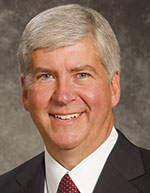Staff Reporter
Mobility, Modernization Top Goals for Colorado and Michigan Governors

Colorado Gov. John Hickenlooper and Michigan Gov. Rick Snyder, whose states have significant freight corridors, set goals to overhaul the infrastructure in their states to ensure that the goods that bolster their economy can move freely.

Hickenlooper
Hickenlooper, a Democrat, said Interstate 70 was a critical east-west corridor in the Denver area on which some 200,000 vehicles crisscross a day.
WHAT'S NEXT?: State DOT Projects Hitting the Road in 2018
LEADERS' OUTLOOK: Gov. Brian Sandoval's State of the States Address
“It’s a huge freight route. [It’s] one of the economic backbones of the state, and it’s very congested,” Hickenlooper told Transport Topics. “That’s our biggest push.”
The Colorado Department of Transportation launched Central 70, a project that involves reconstructing a 10-mile stretch of I-70 that runs through downtown Denver. This year, the agency is adding an express lane in each direction, removing an aging viaduct, lowering the interstate between Brighton and Colorado boulevards and placing a 4-acre cover park over a portion of the lowered interstate.
Colorado’s agriculture, manufacturing and mining industries are among the largest sectors transported primarily outside the state.
Snyder, a Republican, said his roadways will become “smart.”

Snyder
He said that I-75 will be equipped with intelligent transportation systems such as electronic signs and cameras that will help Michigan DOT communicate with drivers about travel times and safety issues.
One of MDOT’s biggest ongoing projects is the replacement of the I-75 Rouge River Bridge, a 1960s-era span south of Detroit that is crossed by nearly 12,500 vehicles daily.
“[We’re] reconstructing the whole thing. It’s a major truck corridor and we’re rebuilding it,” Snyder told Transport Topics. “I think we’re leading in terms of freeway miles we’re making smart. I’m proud. We’re the mobility state. We’re the world’s leader in mobility. We’re working hard to make sure we’re doing that sort of work.”
Construction on the bridge began in 2017 and is expected to finish this year.
Snyder said MDOT is also adding vehicle-to-infrastructure connected technology to routes across the state.
MDOT Director Kirk Steudle said that any new road projects in Michigan will include the fiber necessary to support connected vehicle infrastructure, regardless of when the devices are scheduled to be installed.
“When we reconstruct anything now, whether it’s a freeway or even an arterial, we’re putting brains down below. That’s becoming our standard as to the way we build them.”
Home to the auto industry, automotive powertrains are among the major freight that moves across Michigan, along with sugar beets, sheet steel and gasoline.




